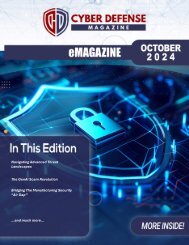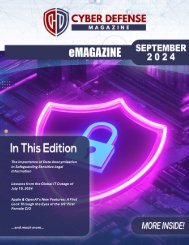Cyber Defense eMagazine June 2020 Edition
Cyber Defense eMagazine June Edition for 2020 #CDM #CYBERDEFENSEMAG @CyberDefenseMag by @Miliefsky a world-renowned cyber security expert and the Publisher of Cyber Defense Magazine as part of the Cyber Defense Media Group as well as Yan Ross, US Editor-in-Chief, Pieruligi Paganini, Co-founder & International Editor-in-Chief, Stevin Miliefsky, President and many more writers, partners and supporters who make this an awesome publication! Thank you all and to our readers! OSINT ROCKS! #CDM #CDMG #OSINT #CYBERSECURITY #INFOSEC #BEST #PRACTICES #TIPS #TECHNIQUES
Cyber Defense eMagazine June Edition for 2020 #CDM #CYBERDEFENSEMAG @CyberDefenseMag by @Miliefsky a world-renowned cyber security expert and the Publisher of Cyber Defense Magazine as part of the Cyber Defense Media Group as well as Yan Ross, US Editor-in-Chief, Pieruligi Paganini, Co-founder & International Editor-in-Chief, Stevin Miliefsky, President and many more writers, partners and supporters who make this an awesome publication! Thank you all and to our readers! OSINT ROCKS! #CDM #CDMG #OSINT #CYBERSECURITY #INFOSEC #BEST #PRACTICES #TIPS #TECHNIQUES
You also want an ePaper? Increase the reach of your titles
YUMPU automatically turns print PDFs into web optimized ePapers that Google loves.
Over the course of this journey, the one thing that has become apparent is that a patchwork network of<br />
legacy solutions isn’t up to the task of keeping the bad actors out. What passed for high tech 15 years<br />
ago is now acting as a hindrance rather than a help. Reliance on legacy systems comes with a list of<br />
disadvantages as long as your arm – everything from unpatched vulnerabilities and point products no<br />
longer suited to today’s environment to cost inefficiencies and a lack of personnel trained to use the<br />
products. These impediments translate into security vulnerabilities that turn government agencies into<br />
sitting ducks from a cybersecurity standpoint. Moreover, legacy solutions are incapable of protecting<br />
dynamically and are limited in the kinds of attacks they can detect and stop.<br />
Unfortunately, the government has lagged behind in adopting new and innovative technologies due, in<br />
part, to a lengthy approval process before a vendor can be sanctioned to work with the Federal<br />
government. Luckily, that’s starting to change. The Department of <strong>Defense</strong> (DoD) has come to recognize<br />
the importance of utilizing pioneering technologies from private-sector companies, as have various<br />
branches of the military. To that end, a grant program through AFWERX and the Small Business<br />
Innovation Research has been developed to foster innovation and speed the vetting process, in effect<br />
giving grant recipients the green light to partner with entities from within the DoD.<br />
Novel times, novel measures<br />
Today’s novel Work from Home (WFH) situation calls for novel security solutions. Thanks to a massive<br />
exodus of workers from the walls of their office buildings to the walls of their homes, the network perimeter<br />
has all but vanished. Remote workers, the use of unsanctioned equipment (that’s also likely to be running<br />
an outdated security solution, assuming it has one at all), data scattered across different locations, and<br />
a variety of cloud services mean but one thing: Shared, cross-network visibility is a must.<br />
Lacking shared visibility and traffic analysis across your network means you are foregoing the chance for<br />
real-time detection and remediation. And while some cloud solutions may bill themselves as offering<br />
“real-time” analytics, if you want to detect and remediate as events happen rather than hours or days,<br />
out-of-the box solutions aren’t going to cut it.<br />
Like enterprises, government entities need real-time protection against millions of network-based threats<br />
across their entire infrastructure, whether it’s on-premises, in the cloud, or a hybrid environment. Today’s<br />
WFH challenges mean an unprecedented number of end-users in remote locations. This makes it even<br />
more critical that network systems utilizing Virtual Private Networks (VPNs) — which by all accounts<br />
come with their own set of security issues — are monitored for any anomalies or known threats that might<br />
be present on the network as a result of using the VPN.<br />
To be truly effective, a system needs to offer network and security teams shared visibility into their<br />
security posture at any — and every — point in time. As government agencies begin to take advantage<br />
of enterprise solutions, they need to ensure that they aren’t simply patching a one legacy solution with<br />
yet another only to cause more problems down the road. Solutions should break down the silos rather<br />
than establish new ones.<br />
Because of the highly sensitive nature of government data, it’s especially important that a security solution<br />
also offers high-performance processing power. This allows complex algorithms to run in real-time, and<br />
means automatic remediation translates into a significant reduction in mean-time-to-repair. Another<br />
<strong>Cyber</strong> <strong>Defense</strong> <strong>eMagazine</strong> –<strong>June</strong> <strong>2020</strong> <strong>Edition</strong> 77<br />
Copyright © <strong>2020</strong>, <strong>Cyber</strong> <strong>Defense</strong> Magazine. All rights reserved worldwide.


















